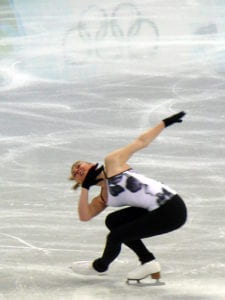Goal 1: Demonstrate advanced competence in pediatric orthoses fabrication, by creating a product using knowledge from scientific research and link to occupational therapy frames of reference.
AOTA Standards of Continuing Competence: Standard 1. Knowledge and Standard 2. Critical Reasoning and Standard 4. Performance Skills.

The sit spin is a basic figure skating spin position, balancing fully on one skate blade and low to the ice. A sit spin requires you to be closed and centered within yourself before opening up the line of the body. It represents my initial learning as in low risk, practicing techniques through trial and error, and reassessing the products within different diagnostic contexts.
Artifact 1 was an important paper that synthesized the initial learning and scientific knowledge about the pediatric population that I was treating. Artifact 1 achieved the goal because I was able to utilize the newly learned knowledge, and critically reason the choice of orthosis materials using occupational therapy frames of reference.
Artifact 1 – Expanding Orthosis Fabrication Knowledge to Pediatrics
Artifact 2 was important because it represented not only the initial stages of trial and error of the atypical materials, but also the successful completion of the products for wear by the clients. By utilizing standardized measures, Artifact 2 achieved the goal of determining the effectiveness of the products. It demonstrated significant improvements in pre and post physical and functional status.
Artifact 2 – Competence Project: Development of Pediatric Orthoses Using Atypical Materials
Reflections
I completed an NYU course called World Dress and Textiles. This course highlighted that what we wear and how we dress is a reflection of our identity. Our dress also reflects to which cultural group we belong. This increased my awareness of how the make and color of my orthoses integrate with how a person dresses. I specifically chose black because any other color can represent an affiliation to gang culture. This was a reality of the urban community in which I practiced as an occupational therapist. However, I learned from advancing my knowledge within artifact 1, to offer subtle color choices to the children for attachments such as strapping and stickers with each visit.
The occupational adaptation frame of reference and the biomechanical frame of reference informed me to think outside of the ‘thermoplastic box’ of orthosis materials for the pediatric population. By introducing atypical materials such as neoprene and aluminum wire into my practice, I was assisting the client in adapting to their environment using a cosmetically acceptable material. I was also soliciting their feedback so that they were a part of the process.
